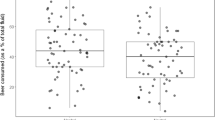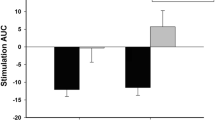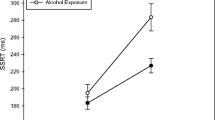Abstract
Rationale
Research has begun to examine how acute cognitive impairment from alcohol could contribute to alcohol abuse. Specifically, alcohol-induced impairment of inhibitory control could compromise the drinker’s ability to stop the self-administration of alcohol, increasing the risk of binge drinking.
Objective
The present study was designed to test this hypothesis by examining the relation between acute alcohol impairment of inhibitory control and alcohol consumption during a single drinking episode.
Materials and methods
Twenty-six healthy adults performed a cued go/no-go task that measured inhibitory control. The study tested the degree to which their inhibitory control was impaired by a moderate dose of alcohol (0.65 g/kg) versus a placebo and the extent to which individual differences in this impairment predicted levels of alcohol consumption as assessed by ad lib drinking in the laboratory.
Results
In accord with the hypothesis, greater impairment of inhibitory control from alcohol was associated with increased ad lib consumption.
Conclusion
Acute impairment of inhibitory control might be an important cognitive effect that contributes to abuse in addition to the positive rewarding effects of the drug.


Similar content being viewed by others
References
Bates ME, Bowden SC, Barry D (2002) Neurocognitive impairment associated with alcohol use disorders: implications for treatment. Exp Clin Psychopharmacol 10:193–212
Cloninger CR (1987) A systematic method for clinical description and classification of personality variants. Arch Gen Psychiatry 44:573–588
Collins RL, Gollnisch G, Izzo C (1996) Drinking restraint and alcohol-related outcomes: exploring the contributions of beverage instructions, beverage content, and self-monitoring. J Stud Alcohol 57:563–571
de Wit H, Chutuape MA (1993) Increased ethanol choice in social drinkers following ethanol preload. Behav Pharmacol 4:29–36
de Wit H, Crean J, Richards JB (2000) Effects of d-amphetamine and ethanol on a measure of behavioral inhibition in humans. Behav Neurosci 114:830–837
DiChiara G, Acquas E, Tanda G (1996) Ethanol as a neurochemical surrogate of conventional reinforcers: the dopamine–opiod link. Alcohol 13:13–17
Fillmore MT (2001) Cognitive preoccupation with alcohol and binge drinking in college students: alcohol-induced priming of the motivation to drink. Psychol Addict Behav 15:325–332
Fillmore MT (2003) Drug abuse as a problem of impaired control: current approaches and findings. Behav Cogn Neurosci Rev 2:179–197
Fillmore MT (2007) Acute alcohol induced impairment of cognitive functions: past and present findings. International Journal of Disability and Human Development 6:115–125
Fillmore MT, Vogel-Sprott M (1998) Behavioral impairment under alcohol: cognitive and pharmacokinetic factors. Alcohol Clin Exp Res 22:1476–1482
Fillmore MT, Vogel-Sprott M (2000) Response inhibition under alcohol: effects of cognitive and motivational conflict. J Stud Alcohol 61:872–880
Fillmore MT, Rush CR (2001) Alcohol effects on inhibitory and activational response strategies in the acquisition of alcohol and other reinforcers: priming the motivation to drink. J Stud Alcohol 62:646–656
Fillmore MT, Blackburn J (2002) Compensating for alcohol-induced impairment: alcohol expectancies and behavioral disinhibition. J Stud Alcohol 63:237–246
Fillmore MT, Marczinski CA, Bowman AM (2005) Acute tolerance to alcohol effects on inhibitory and activational mechanisms of behavioral control. J Stud Alcohol 66:663–672
Finn PR, Kessler DN, Hussong AM (1994) Risk for alcoholism and classical conditioning to signals for punishment: evidence for a weak behavioral inhibition system? J Abnorm Psychol 103:293–301
Fowles DC (1987) Application of a behavioral theory of motivation to the concepts of anxiety and impulsivity. J Res Pers 21:417–435
Gray JA (1976) The behavioral inhibition system: a possible substrate for anxiety. In: Feldman MP, Broadhurst A (eds) Theoretical and experimental bases of the behavior therapies. Wiley, London, pp 3–41
Jentsch JD, Taylor JR (1999) Impulsivity resulting from frontostriatal dysfunction in drug abuse: implication for the control of behavior by reward-related stimuli. Psychopharmacology 146:373–390
Katz JL, Higgins ST (2003) The validity of the reinstatement model of craving and relapse to drug use. Psychopharmacology 168:21–30
Koob GF (2003) Neuroadaptive mechanisms of addiction: studies on the extended amygdala. Eur Neuropsychopharmacol 13:442–452
Koob GF, Le Moal M (1997) Drug abuse: hedonic homeostatic dysregulation. Science 278:52–58
Koob GF, Rocio M, Carrera A, Gold LH, Heyser CJ, Maldonado-Irizarry C et al (1998) Substance dependence as a compulsive behavior. J Psychopharmacol 12:39–48
Logan GD (1994) On the ability to inhibit thought and action: a user’s guide to the stop-signal paradigm. In: Dagenback D, Carr TH (eds) Inhibitory processes in attention, memory, and language. Academic, San Diego, pp 189–239
Logan GD, Cowan WB (1984) On the ability to inhibit thought and action: a theory of an act of control. Psychol Rev 91:295–327
Ludwig AM, Wikler A, Stark LH (1974) The first drink: psychobiological aspects of craving. Arch Gen Psychiatry 30:539–547
Lyvers M (2000) “Loss of control” in alcoholism and drug addiction: a neuroscientific interpretation. Exp Clin Psychopharmacol 8:225–249
Marczinski CA, Fillmore MT (2003) Preresponse cues reduce the impairing effects of alcohol on the execution and suppression of responses. Exp Clin Psychopharmacol 11:110–117
Marczinski CA, Bryant R, Fillmore MT (2005) The relationship between cognitive preoccupation with alcohol and alcohol use in male and female college students. Addiction Research and Theory 13:383–394
Marlatt GA, Demming B, Reid JB (1973) Loss of control drinking in alcoholics: an experimental analogue. J Abnorm Psychol 81:233–241
McKim WA (2007) Drugs and behavior: an introduction to behavioral pharmacology, 6th edn. Prentice Hall, New Jersey
Miller J, Schaffer R, Hackley SA (1991) Effects of preliminary information in a go versus no-go task. Acta Psychol 76:241–292
Mulvihill LE, Skilling TA, Vogel-Sprott M (1997) Alcohol and the ability to inhibit behavior in men and women. J Stud Alcohol 58:600–605
National Institute on Alcohol Abuse and Alcoholism (2004) NIAAA council approves definition of binge drinking. NIAAA Newsletter, No. 3, Winter 2004
Patton JH, Stanford MS, Barratt ES (1995) Factor structure of the Barratt Impulsiveness Scale. J Clin Psychol 51:768–774
Posner MI (1980) Orienting of attention. Q J Exp Psychol 32:3–25
Robinson TE, Berridge KC (1993) The neural basis of drug craving: an incentive-sensitization theory of addiction. Brain Res Rev 18:247–291
Roehrich L, Goldman M (1995) Implicit priming of alcohol expectancy memory processes and subsequent drinking behavior. Exp Clin Psychopharmacol 3:402–410
Schneider W, Eschman A, Zuccolotto A (2002) E-prime user’s guide. Psychology Software Tools, Pittsburgh, PA
Seltzer ML, Vinokur A, van Rooijen L (1975) A self-administered Short Michigan Alcoholism Screening Test (SMAST). J Stud Alcohol 36:117–126
Shaham Y, Shalev U, Lu L, de Wit H, Stewart J (2003) The reinstatement model of drug relapse: history, methodology, and major findings. Psychopharmacology 168:3–20
Sher KJ, Trull TJ (1994) Personality and disinhibitory psychopathology: alcoholism and antisocial personality disorder. J Abnorm Psychol 103:92–102
Stein KD, Goldman MS, Del Boca FK (2000) The influence of alcohol expectancy priming and mood manipulation on subsequent alcohol consumption. J Abnorm Psychol 109:106–115
Stewart J, de Wit H, Eikelboom R (1984) Role of unconditioned and conditioned drug effects in the self-administration of opiates and stimulants. Psychol Rev 91:251–268
Vogel-Sprott M (1992) Alcohol tolerance and social drinking: learning the consequences. Guilford, New York
Wiers RW, Stacy AW (2006) Implicit cognition and addiction: an introduction. In: Wiers RW, Stacy AW (eds) Handbook of implicit cognition and addiction. Sage, London, pp 1–8
Widiger TA, Smith GT (1994) Substance use disorder: abuse, dependence and dyscontrol. Addiction 89:267–282
Wise RA, Bozarth MA (1987) A psychomotor stimulant theory of addiction. Psychol Rev 94:469–492
Acknowledgement
This research was supported by grant R21 DA021027 from the National Institute on Drug Abuse and by grant R01 AA12895 from the National Institute on Alcohol Abuse and Alcoholism.
Author information
Authors and Affiliations
Corresponding author
Rights and permissions
About this article
Cite this article
Weafer, J., Fillmore, M.T. Individual differences in acute alcohol impairment of inhibitory control predict ad libitum alcohol consumption. Psychopharmacology 201, 315–324 (2008). https://doi.org/10.1007/s00213-008-1284-7
Received:
Accepted:
Published:
Issue Date:
DOI: https://doi.org/10.1007/s00213-008-1284-7




